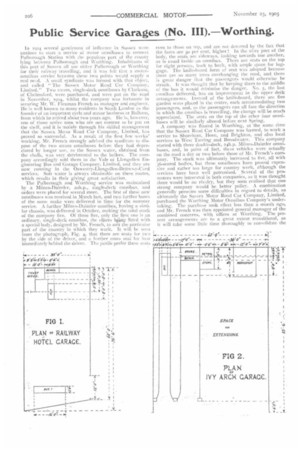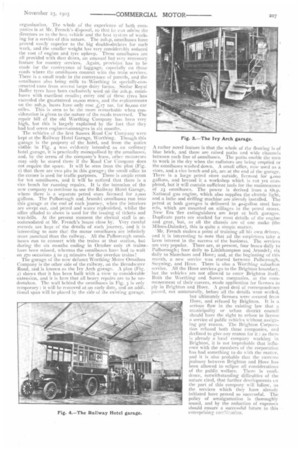Public Service Garages (No. III). Worthing.
Page 10

Page 11

If you've noticed an error in this article please click here to report it so we can fix it.
In 1004 several gentlemen of influence in Sussex were anxious to start a service of motor omnibuses to connect Pulborough Station with the populous part of the county lying between Pulborough and Worthing,. Inhabitants of this part of Sussex all use either Pulborough or Worthingfor their railway travelling, and it was felt that a nuthlromnibus service between these two points wculd supply a real need. A small syndicate was formed with that object, and called " The Sussex Motor Road Car Company, Limited." Two s-xam, single-deck omnibuses by Clarkson, of Chelmsford, were purchased, and were put on the road in November, No4, whilst the company was fortunate in securing Mr. W. Flexman French as manager and engineer. He is well known to many residents in South London as the founder of an important cycle and motor business at Balham, from which he retired about two years ago. He is, however, one of those active men who are not content to he put on the shelf, and it is mainly through his skilful management that the Sussex Moor Road Car Company, Limited, has proved so successful. As a result of the first few weeks' working, Mr. French strongly advised the syndicate to dispose of the two steam omnibuses before they had depreciated by longer use, as the Sussex water, obtained from the chalk, was very detrimental to the boilers. The Corn. patty accordingly sold them to the Vale of Llangollen Engineering Bus and Garage Company, Limited, and they are now running in the Oswestry-Llangollen-Bettws-y-.Coed services. Soft water is always obtainable on these routes, which results in their giving great satisfaction. The Pulborough and Worthing service was maintained by a Milnes-Daimler, 2oh.p., single-deck omnibus, and orders were placed for several more. The first of these new omnibuses was received in March last, and two further buses of the same make were delivered in time for the summer service. A further Milnes-Daimler omnibus, having a similar chassis, was delivered in October, making the total stock of the company five. Of these five, only the first one is an ordinary, single-deck omnibus, the others llging fitted with a special body, designed by Mr. French, to suit the particuiar part of the country in which they work. It will be seen , from the photograph, Fig. 4, that there are Seats for two by the side of the driver, and a further cross seat for foalimmediately behind the driver. The public prefer these snts A even to those on top, and are not deterred by the fact that the fares are so per cent. higher ! In the alter part of the body, the seats are sideways, looking towards one another, as is usual inside an omnibus. There are seats on the top for eight persons, back to back, with ample space for luggage. The knife-board form of seat was adopted because there arc so many trees overhanging the road, and there is great danger that the passengers would otherwise be struck. It was Thought that by keeping them to the middle o the. bus it would minimise the danger. No. 5, the last omnibus delivered, has an improvement in the upper deck arrangements. Instead of the knife-board, there are five garden seats placed in the centre, each accommodating two passengers, and, as the passengers can all face the direction in which the omnibus is travelling, the change will be much appreciated. The seats on the top of the other four omnibuses \Via be similarly altered before next Spring. A company was floated in Worthing, at the same time that the Sussex Road Car Company was formed, to work a service to Shoreham, Hove, and Brighton, and also local services to West Tarring and Broadwater. This company started with three double-deck, 2 4h.p. Mil n esDaimler omnibuses, and, in point of fact, these vehicles were actually on the road a day or Iwo before those of Mr. French's company. The stock was ultimately increased to five, all with 36-seated bodies, but these omnibuses hare proved expensive and rather too large for country work, although the services have been well patronised. Several of the promoters were interested in both companies, as it was thought there would be no rivalry, but they soon realised that one strong company would be better policy. A combination generally presents some difficulties in regard to details, so ultimately the Sussex Motor Road Car Company, Limited, purchased the Worthing Motor Omnibus Company's undertaking. The purchase took effect less than a month ago, and Mr. French was then appointed general manager of the combined concerns, with offices at Worthing. The present arrangements are to a great extent transitional, as it will take some little time thoroughly to consolidate the
organisation. The whole of the experience of both companies is at Mr. French's disposal, so that lie can advise the directors as to the best vehicle and the best system of working for a service of this nature. The 2011.p. omnibuses have Proved vastly superior to the big double-deckers for such work, and the smaller weight has very considerably reduced the cost of engine and tyre upkeep. These omnibuses are all provided with dust deors, an unusual but very necessary feature for country services. Again, provision has to be made for the conveyance of •luggage, especially on those roads where the omnibuses connect with the train. services. .There is a small trade in the conveyance of parcels, and the omnibuses also bring milk to Worthing in specially-constructed cans from several large dairy farms. Sirdar Royal Buffer tyres have been exclusively lased au the 2011.1). omnibuses with excellent results; every on of these tyres has exceeded the guaranteed moots miles, and the mplacements on the 2oh.p. buses have only cost f;l7 los. for So,000 car miles. This is seen to be the more remarkable when consideration is given to the nature of the roads traversed. The repair bill of the old Worthing Company has been very high, but this is largely explained by the fact that they had had seven engineer-managers in six months. .
The vehicles of the first Sussex Road Car Company were kept at the Railway Hotel Garage, Worthing.. Though this garage is the property of the hotel, and from the notice visible in Fig. 4 was evidently intended as an ordinary hotel garage, it is practically monopolised by the omnibuses, and, by the terms of the company's lease, other motorcars may only be stored there if the Road Car Company does not require the space. It will be seen from the plan (Fig. that there are two pits in this garage; the small office in the corner is used for traffic purposes. There is ample room for ten omnibuses, and it will be noticed that there is a vice bench for running repairs. It is the intention of the new company to continue to use the Railway Hotel Garage, where there is a separate petrol store licensed for 2,000 gallons. The Pulborough and Arundel omnibuses run into this garage at the end of each journey, when the interiors are swept out, and petrol and water replenished, whilst the office alluded to above is used for the issuing of tickets and way-bills. At the present moment the clerical staff is accommodated at Mr. French's house close by. Very careful records are kept of the details of each journey, and, it is interesting to note that the motor omnibuses are infinitely more punctual than the railway. All the Pulborough omnibuses run to connect with the trains at that station, but during the six months ending in October only 18 trains. have been missed, whereas the omnibuses have had to wait on 270 occasions 5 to 25 minutes for the overdue trains! The garage of the now defunct Worthing Motor Omnibus Company is the other side of the railway, on the Broadwater Road, and is known as the Ivy Arch garage. A plan (Fig. i) shows that it has been built with a view to considerable extension, and it is here that all heavy repairs are to be undertaken. The wall behind the omnibuses in Fig. 3 is only temporary : it will be removed at an early date, and an additional span will be placed by the side of the existing garage. A rather novel feature is that the whole of the flooring is of blue brick, and there are raised paths and wide channels between each line of omnibuses. The paths enable the men to work in the dry when the radiators are being emptied. or the omnibuses washed down. A small office, now used as a store, and a vice bench and pit, are at the end of the garage. There is a large petrol store outside, licensed for 4,000 gallons, and beyond it a workshop which is not yet completed, but it will contain sufficient tools for the maintenance of 25 omnibuses. The power is derived from a fih.p. National gas engine, which also supplies the electric light, and a lathe and drilling machine are already installed. The petrol at both garages is delivered in 40-gallon steel barrels, which are mounted on stillages in the petrol stores. New Era ;fire extinguishers an kept at both garages. Duplicate parts are stocked for most details of the engine and gear, hut, as all the chassis are of one make (the Milnes-Daimler), this is quite a simple matter. 'Mr. French makes a point of training all hi, own drivers, and it is interesting to note that ad the employees take a keen interest in the success of the business. The services are very popular. There are, at present, four buses daily to Pulborough; four daily to Littlehampton and. Arundel; six daily to Shoreham and Hove; and, at the beginning of this month, a new service was started between Pulberough, Steyning, and Hove. There is also a Worthing suburban service. All the Hove services go to the Brighton boundary, but the vehicles are not allowed to enter Brighton itself. Both the Worthing and Sussex companies, at the commencement of their careers, made applimtion for licenses to ply in Brighton and Hove. A good deal of correspondence passed. not unnaturally, before all the details were settled, hut ultimately licenses were secured from I love, and refused by Brighton. It is a serious flaw in the existing law that a municipality or urban district council should have the right to refuse to license a service of public vehicles without assigning Qny reason. The Brighton Corporation refused both these companies, and declined to give any reason for it : as there is already a local company working in Brighton, it is not improbable that influence with the members of the corporation has had something to do with the matter, and it is also probable that the extreme jealousy between Brighton and Hove has been allowed to eclipse all considerations of the public welfare. There is confidence, notwithstanding difficulties of the nature cited, that further developments to the part of this company will follow, as the services which they have already initiated have proved so successful. The policy of amalgamation is thoroughly sound, and by the reduction of expenses should ensure a successful future to this enterprising con*ination.








































